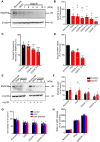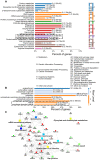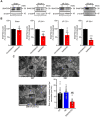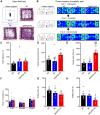Decreased neuronal synaptosome associated protein 29 contributes to poststroke cognitive impairment by disrupting presynaptic maintenance
- PMID: 33754017
- PMCID: PMC7978312
- DOI: 10.7150/thno.54210
Decreased neuronal synaptosome associated protein 29 contributes to poststroke cognitive impairment by disrupting presynaptic maintenance
Abstract
Background: Poststroke cognitive impairments are common in stroke survivors, and pose a high risk of incident dementia. However, the cause of these cognitive impairments is obscure and required an investigation. Methods: Oxygen-glucose deprivation (OGD) model and middle cerebral artery occlusion (MCAO) model were used to imitate in vitro or in vivo acute cerebral ischemia, respectively. The differentially expressed synaptosome associated protein 29 (SNAP29)-interacting proteins upon ischemia and reperfusion were analyzed with bioinformatics analysis and the results indicated that the changes of SNAP29 after acute ischemia were mainly involved in the synaptic functions. The outcomes of SNAP29 reduction were assessed with SNAP29 knockdown, which mimicked the distribution of SNAP29 along neuronal processes after acute ischemia. Using the whole-cell patch clamp recording method and transmission electron microscope, the pre-synaptic function and readily releasable pool (RRP) were observed after SNAP29 knock down. Using photogenetic manipulations and behavioral tests, the neuronal projection and cognitive functions of mice with SNAP29 knock down in hippocampus CA1 region were evaluated. Results: It was found that SNAP29 protein levels decreased in both in vitro and in vivo ischemic models. Further, the SNAP29 reduction wasn't associated with impaired autophagy flux and neuronal survival. When SNAP29 was knocked down in primary cortical neurons, the frequency of AMPARs-mediated mEPSCs, but not the amplitude, significantly decreased. Meanwhile, the mice with SNAP29 knockdown at CA1 region of hippocampus developed an impairment in hippocampus-mPFC (middle prefrontal cortex) circuit and behavioral dysfunctions. Moreover, the size of RRP at presynaptic sites was diminished. Conclusion: Since SNAP29 protein levels didn't significantly influence the neuronal survival and its decrease was sufficient to disturb the neural circuit via a presynaptic manner, the SNAP29-associated strategies may be an efficient target against poststroke synaptic dysfunction and cognitive deficits.
Keywords: SNAP29; cognitive impairment; ischemic stroke; synaptic function; synaptic vesicle release.
© The author(s).
Conflict of interest statement
Competing Interests: The authors have declared that no competing interest exists.
Figures








Similar articles
-
O-GlcNAc-modified SNAP29 inhibits autophagy-mediated degradation via the disturbed SNAP29-STX17-VAMP8 complex and exacerbates myocardial injury in type I diabetic rats.Int J Mol Med. 2018 Dec;42(6):3278-3290. doi: 10.3892/ijmm.2018.3866. Epub 2018 Sep 7. Int J Mol Med. 2018. PMID: 30221662 Free PMC article.
-
Generation and Characterization of a CRISPR/Cas9-Mediated SNAP29 Knockout in Human Fibroblasts.Int J Mol Sci. 2021 May 18;22(10):5293. doi: 10.3390/ijms22105293. Int J Mol Sci. 2021. PMID: 34069872 Free PMC article.
-
Impaired synaptic vesicle recycling contributes to presynaptic dysfunction in lipoprotein lipase-deficient mice.Neuroscience. 2014 Nov 7;280:275-81. doi: 10.1016/j.neuroscience.2014.07.080. Epub 2014 Sep 3. Neuroscience. 2014. PMID: 25194787
-
Snapshots from within the cell: Novel trafficking and non trafficking functions of Snap29 during tissue morphogenesis.Semin Cell Dev Biol. 2023 Jan 15;133:42-52. doi: 10.1016/j.semcdb.2022.02.024. Epub 2022 Mar 4. Semin Cell Dev Biol. 2023. PMID: 35256275 Review.
-
Vesicle pools and short-term synaptic depression: lessons from a large synapse.Trends Neurosci. 2002 Apr;25(4):206-12. doi: 10.1016/s0166-2236(02)02139-2. Trends Neurosci. 2002. PMID: 11998689 Review.
Cited by
-
Microglial autophagy in cerebrovascular diseases.Front Aging Neurosci. 2022 Oct 6;14:1023679. doi: 10.3389/fnagi.2022.1023679. eCollection 2022. Front Aging Neurosci. 2022. PMID: 36275005 Free PMC article. Review.
-
Excitatory Synaptic Transmission in Ischemic Stroke: A New Outlet for Classical Neuroprotective Strategies.Int J Mol Sci. 2022 Aug 19;23(16):9381. doi: 10.3390/ijms23169381. Int J Mol Sci. 2022. PMID: 36012647 Free PMC article. Review.
-
Effect of Butylphthalide combined with Oxiracetam on cognitive function, Intellectual recovery and serum inflammatory factors in patients with cognitive impairment after cerebral infarction.Pak J Med Sci. 2023 Mar-Apr;39(2):485-490. doi: 10.12669/pjms.39.2.6901. Pak J Med Sci. 2023. PMID: 36950397 Free PMC article.
-
Copper Induces Cognitive Impairment in Mice via Modulation of Cuproptosis and CREB Signaling.Nutrients. 2023 Feb 15;15(4):972. doi: 10.3390/nu15040972. Nutrients. 2023. PMID: 36839332 Free PMC article.
-
Frequency and duration of sensory flicker control transcriptional profiles in 5xFAD mice.APL Bioeng. 2025 Jul 8;9(3):036102. doi: 10.1063/5.0261497. eCollection 2025 Sep. APL Bioeng. 2025. PMID: 40642323 Free PMC article.
References
-
- Feigin VL, Norrving B, Mensah GA. Global Burden of Stroke. Circ Res. 2017;120:439–48. - PubMed
-
- Nys GM, van Zandvoort MJ, van der Worp HB, de Haan EH, de Kort PL, Jansen BP. et al. Early cognitive impairment predicts long-term depressive symptoms and quality of life after stroke. J Neurol Sci. 2006;247:149–56. - PubMed
-
- Sachdev PS, Chen X, Brodaty H, Thompson C, Altendorf A, Wen W. The determinants and longitudinal course of post-stroke mild cognitive impairment. J Int Neuropsychol Soc. 2009;15:915–23. - PubMed
Publication types
MeSH terms
Substances
LinkOut - more resources
Full Text Sources
Other Literature Sources
Medical
Molecular Biology Databases
Miscellaneous

